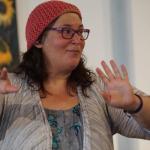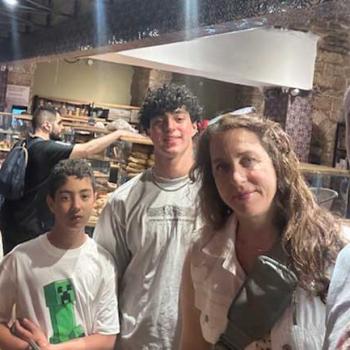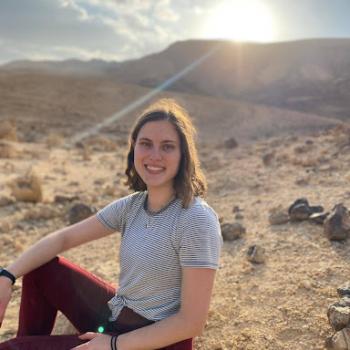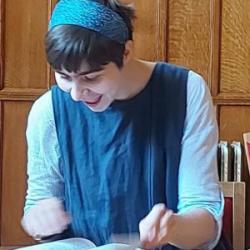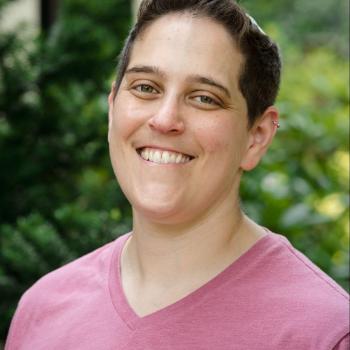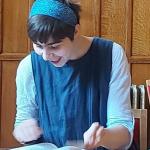By Rabbi Jessica Kate Meyer ’14, Hebrew College Artist in Residence and Rosh Tefila
Parashat Ki Tissa Exodus 30:11-34:35
Oh so many censuses (censi?) in the Torah. Why must God count us all the time? Our rabbi ancestors explain it with a mashal, a parable: To what can we compare God counting us? To a king with overflowing treasures. In the corner of his palace lies a box of semi-precious stones. Nothing flashy. For some inexplicable reason, the king loves these stones, loves them so much that he comes back to them over and over to hold each one in his hand, to see them with his eyes, to remind himself that they are there.
So too, God counts the Israelites lovingly (perhaps obsessively), confirming that each one of us is still there, in all of our semi-preciousness.
If God craves such reassurance, all the more so, we humans want to feel our dear ones close by and accounted for. In 1958, psychiatrist John Bowlby developed Attachment Theory, based on the observation that human beings innately crave proximity to one another, or, in clinical terms to ‘attachment figures.’ For infants, the parent or primary caregiver is the attachment figure, and all of our relationships throughout life trace back to this original bond. We constantly monitor our distance to this person, to ensure they are not too far away, that their gaze and body language communicate love. If the attachment figure is perceived as unavailable or closed off, if there’s a disruption or discontinuity in the bond, we lose our inner equilibrium. We might become clingy, embodying an anxious attachment; or else default to avoidant attachment, resisting contact and detaching from the one we dearly love.
While God’s obsession with censuses might be a sign of anxious attachment, God isn’t the only one with attachment issues in this parashah.
A few verses later, and we’re the ones counting…the days, the minutes, the seconds until the object of our love, our attachment figure, will return to us. Moshe, our primary human caregiver, who tells us when it’s time to go or stay or fight or bathe, has left the human plane of existence for a 40 day retreat with God on top of the mountain. And we don’t know what’s happened to him. We only know he’s not here, and that is terrifying.
Moses’s apparent disappearance is a massive attachment rupture, and it sets off debilitating anxiety that leads to clinginess, violence and the search for a substitute, a new attachment object to cling to. Enter the Golden Calf.
We throw ourselves into full body devotion to the new attachment figure: prostrating, dancing, gazing into its empty eyes.
As we know, it doesn’t end well. Moses comes down from the mountain, sees how he has been abandoned, flies into a rage, shatters the tablets. He melts down, pulverizes the golden calf and forces the people to drink its remains. All we wanted was secure attachment, reciprocity, relationship. That’s what Moses wanted too. When he saw himself replaced by a statue, he ground that thing to a pulp, commanded the Levites to kill everyone who clung to it. A rupture throws the whole story off kilter, and causes the original sin of our people.
In Attachment Theory, the question isn’t how we avoid ruptures. Rupture is a given. Rather, how do we recalibrate after such rupture? How do we re-attune? How do we cope when the object of attachment shows us their back instead of the face we so desire to see?
There is a clue at the beginning of this week’s parashah:
כִּי תִשָּׂא אֶת־רֹאשׁ בְּנֵי־יִשְׂרָאֵל לִפְקֻדֵיהֶם
When you you lift up the head of each Israelite person to number them (Exodus 30:12)
Re-attunement includes a physical realignment, an unfurling from gripped fists and tensed bodies, lengthening from a place of bent-over shame into standing tall. It’s lifting up each other’s faces, gazing into one another’s eyes rather than avoiding contact. We know from later in the parashah that this verb נשא—nun, sin, alef—also means to carry together.
Stunningly, the same root letters נ.ש.א. also means to forgive, as when God is described in the Thirteen Attributes as nosei avon va fesha (forgiving sin and iniquity). (See Exodus 34:7) Forgiveness, lifting up, and carrying together spring from the same source. In our society, we often understand forgiveness as an individual undertaking, a personal transformation. In Hebrew, the beginning of re-attunement is teshuva (return) and forgiveness, a process of lifting/carrying a shared burden together.
Moses returns to God. And repeats over and over: “Let me find favor in your eyes.” He, Moses, is lifting his head toward God, and he is asking for the non-verbal cues of care, of reciprocity that were once integral to their relationship. He asks God to forgive the people and asks God to once again join him in carrying them together, toward the Promised Land.
Initially God says: I’m not coming. I’ll send a messenger to help, but you’ll get to the Promised Land without me. (Exodus 32:34) God is avoidant, but Moshe persists: If you aren’t going with us, don’t send us at all. The ultimate goal here is not getting to the Land, the goal is going there together; in relationship. There is no milk and honey without You.
And God accedes. God and Moses begin to re-attune after rupture. And the story can go on.
We are all wired for social attachment. We bond, we cling, we run away, we endure rupture.
And we learn, b’ezrat haShem—with God’s help—what it means to return to each other, and to the divine.
Jessica Kate Meyer, Hebrew College Rabbinical School ’14, is a prayer leader, storyteller, vocalist, and rabbi, who served as rabbi-hazzan at Romemu in NYC, and most recently, at The Kitchen in San Francisco. She has studied sacred Jewish music with masters from Ashkenazi and Mizrahi traditions and has performed as a vocalist with ensembles in the United States and Israel. In a previous life, Jessica appeared in film, theater, and television projects in Europe and the United States: most notably, as a principal role in the Oscar-winning film,The Pianist.



